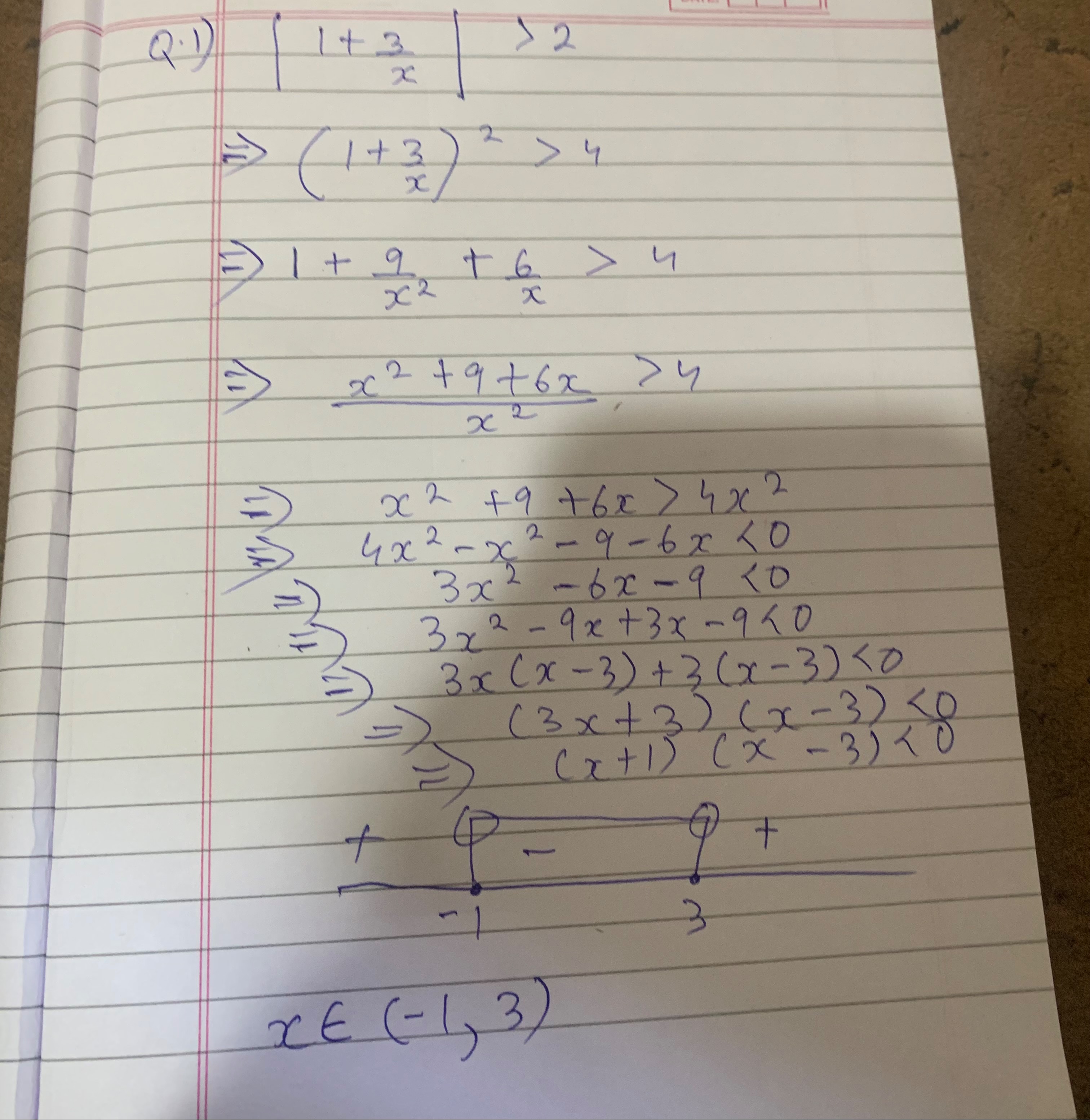Question
Question: Q.1) $\left|1+\frac{3}{x}\right|>2$ $\Rightarrow \left(1+\frac{3}{x}\right)^2>4$ $\Rightarrow 1+\f...
Q.1) 1+x3>2
⇒(1+x3)2>4
⇒1+x29+x6>4
⇒x2x2+9+6x>4
⇒x2+9+6x>4x2
⇒4x2−x2−9−6x<0
⇒3x2−6x−9<0
⇒3x2−9x+3x−9<0
⇒3x(x−3)+3(x−3)<0
⇒(3x+3)(x−3)<0
⇒(x+1)(x−3)<0

x∈(−1,3)
Solution
The problem is to solve the inequality 1+x3>2.
Method 1: Using the definition of absolute value.
∣A∣>b is equivalent to A>b or A<−b. In this case, A=1+x3 and b=2. So, we have two cases:
Case 1: 1+x3>2
x3>2−1
x3>1
x3−1>0
x3−x>0
To solve this inequality, we find the critical points where the numerator or denominator is zero. These are x=3 and x=0. We analyze the sign of the expression x3−x in the intervals (−∞,0), (0,3), and (3,∞).
-
For x∈(−∞,0), let x=−1. −13−(−1)=−14=−4<0.
-
For x∈(0,3), let x=1. 13−1=12=2>0.
-
For x∈(3,∞), let x=4. 43−4=4−1<0.
The inequality x3−x>0 is satisfied for x∈(0,3).
Case 2: 1+x3<−2
x3<−2−1
x3<−3
x3+3<0
x3+3x<0
x3(1+x)<0
x1+x<0
The critical points are where the numerator or denominator is zero. These are x=−1 and x=0. We analyze the sign of the expression x1+x in the intervals (−∞,−1), (−1,0), and (0,∞).
-
For x∈(−∞,−1), let x=−2. −21+(−2)=−2−1=21>0.
-
For x∈(−1,0), let x=−0.5. −0.51+(−0.5)=−0.50.5=−1<0.
-
For x∈(0,∞), let x=1. 11+1=12=2>0.
The inequality x1+x<0 is satisfied for x∈(−1,0).
The solution to the original inequality is the union of the solutions from Case 1 and Case 2. Solution set = (0,3)∪(−1,0). This can also be written as x∈(−1,3) and x=0.
Method 2: Squaring both sides.
1+x3>2 Square both sides: (1+x3)2>4.
1+2⋅1⋅x3+(x3)2>4
1+x6+x29>4
Combine terms on the left side: x2x2+x26x+x29>4
x2x2+6x+9>4
Subtract 4 from both sides: x2x2+6x+9−4>0
x2x2+6x+9−4x2>0
x2−3x2+6x+9>0
Factor the numerator: x2−3(x2−2x−3)>0
x2−3(x+1)(x−3)>0
Divide by -3 and reverse the inequality sign: x2(x+1)(x−3)<0
For this inequality to hold, the numerator (x+1)(x−3) and the denominator x2 must have opposite signs. Since x2≥0, and x=0 (from the original inequality), we have x2>0. Therefore, the numerator must be negative: (x+1)(x−3)<0
The critical points are x=−1 and x=3. The quadratic expression (x+1)(x−3) is a parabola opening upwards, so it is negative between the roots. The solution to (x+1)(x−3)<0 is x∈(−1,3). However, we must also satisfy the condition that the denominator x2 is non-zero, which means x=0. So, the solution is x∈(−1,3) and x=0. This gives the solution set (−1,0)∪(0,3).
The provided solution incorrectly concludes that the solution is x∈(−1,3) after obtaining (x+1)(x−3)<0. It failed to consider the restriction x=0 imposed by the original inequality.
The final answer is (−1,0)∪(0,3).
Explanation of the solution: The inequality is 1+x3>2. This is equivalent to 1+x3>2 or 1+x3<−2.
Case 1: 1+x3>2⇒x3>1⇒x3−x>0. This inequality holds for x∈(0,3).
Case 2: 1+x3<−2⇒x3<−3⇒x3+3x<0⇒x1+x<0. This inequality holds for x∈(−1,0).
The solution is the union of the solutions from Case 1 and Case 2, which is (−1,0)∪(0,3).
The final answer is (−1,0)∪(0,3).
Subject: Mathematics Chapter: Relations and Functions (Inequalities are typically covered in this context, or in Algebra) Topic: Inequalities involving absolute values
Difficulty level: Medium
Question type: descriptive (although it asks to solve, the format of the provided solution suggests it is a problem where steps and final answer are expected)
The provided solution is incorrect because it does not exclude x=0 from the solution set. The correct solution is (−1,0)∪(0,3).
Since I need to provide the solution based on the provided format, which seems to be a step-by-step derivation, I will present the corrected steps based on the squaring method.
Corrected solution based on the provided approach:
1+x3>2 Square both sides: (1+x3)2>4
1+x6+x29>4
x2x2+6x+9>4
x2x2+6x+9−4>0
x2x2+6x+9−4x2>0
x2−3x2+6x+9>0
x2−3(x2−2x−3)>0
Since x2>0 for x=0, we need −3(x2−2x−3)>0.
x2−2x−3<0
(x+1)(x−3)<0
This inequality holds for x∈(−1,3). Considering the restriction x=0, the solution is x∈(−1,3)∖{0}, which is x∈(−1,0)∪(0,3).
The final answer is (−1,0)∪(0,3).
The final answer is (−1,0)∪(0,3).
